|
It's late May and practice time for the Stromsgodset Toppfotball club in Drammen, Norway. As the players are dressing, sporting director Jostein Flo informs them that a new recruit will be joining them to try out. He tells them the recruit is "damn fast." The door opens and in walks a man they instantly recognize. They can't believe their eyes, -- or the number on the back of his jersey: 9.58. Welcome, Usain Bolt, to the world of football. And welcome, world, to the idea that the 32-year-old world-record-holder in both the 100 meters (9.58 seconds) and 200 meters (19.19) wants to play wing on a professional soccer team now that he's retired from track and field. What nicer challenge can there be than to play a sport he has loved since his boyhood days in Sherwood Content, Jamaica? Starting on Tuesday, Bolt will begin training in Gosford, Australia, with the Central Coast Mariners of the A-League. The eight-time Olympic gold medalist has been dipping his toes into pitches in South Africa, Germany and Norway this year while his agent has been fielding enquiries from clubs in Turkey, America's United Soccer League and the A-League. Ultimately, Bolt chose the Mariners, in part because of his familiarity with the territory -- he helped bankroll an Australian track league. "I always say that anything is possible," Bolt said when his audition was first announced. "Don't think limits. I look forward to the challenge." There are those who see this as a shameless ploy to boost attendance and viewership for the A-League in general, and the lowly Mariners in particular. But hold the skepticism for at least a few weeks of training. There's a YouTube clip of Bolt playing in a Soccer Aid for UNICEF exhibition in Manchester, England, on June 10, and he narrowly missed a hat trick: one goal was disallowed because of an offsides call, one shot went just wide and another hit the junction of the crossbar and sidebar. The very thought of a right wing with his speed is both intriguing and intimidating. Said Brisbane Roar striker Adam Taggart, "I'm just happy I'm not a defender having to run against him if he does come." Or put it this way: the fastest current pro is probably Gareth Bale of Real Madrid, who has been clocked doing 36.9 kilometers per hour (22.9 mph) during a game. Bolt can run as fast as 40 kph (25 mph). There is a rich history of athletes finding success in other arenas. The list of trans-sports greats -- Jim Thorpe, Babe Zaharias, Jackie Robinson, Jim Brown, Bob Hayes, Bo Jackson, Deion Sanders, Marion Jones -- goes on and on. But wherever they went, whatever they did, they heard the cheers and accolades. What distinguishes Bolt and the other noteworthy genre-busting athletes profiled below is the willingness to listen to their hearts and the unwillingness to listen to the chorus of people who told them that they're too old or that their sports are too dissimilar or that it's never been done before. Maybe they find failure, but at least they tried -- and for that, they should hear bravos, not jeers. Cleveland Indians manager Terry Francona has some experience in that area: He was Michael Jordan's manager in MLB's minor league in 1994. "It was fashionable to be critical of Michael. But from what I saw, he had respect for the game and gained the respect of his teammates," Francona said. "He was just a joy to have around. I don't know how Bolt is being treated, but good for him." Sometimes, the chorus is wrong. After all, Usain Bolt used to hear that he was too lazy and mischievous to become a champion. What if he is good enough to make the Mariners? And so what if he's not? Michael Jordan, United States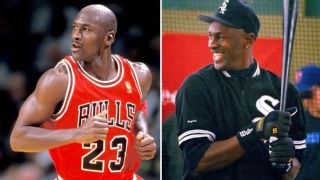 The greatest basketball player who ever lived is also the best example of why we shouldn't laugh at an athlete's ambition. When the 30-year-old Jordan announced his retirement from the NBA in October 1993 after leading the Chicago Bulls to their third straight NBA championship, most people understood. He was in mourning over the death of his father, he was in the midst of a controversy over his gambling and he had nothing left to prove. What most people didn't understand was his announcement three months later that he wanted to try out for the Chicago White Sox, an MLB team owned by Jerry Reinsdorf, the Bulls' owner. So when he reported to spring training in Sarasota, he was met by a chorus of skeptics. I was one of them. At the time, I was writing for Sports Illustrated, and in my story archly entitled "Err Jordan", I was pretty rough on him: "MJ has no more business playing right field in Comiskey Park than [elderly White Sox legend] Minnie Minoso has bringing the ball upcourt for the Chicago Bulls." But I did note that his teammates were impressed with both his speed and his work ethic, even if the bat speed and nomenclature weren't quite there (he called the first base ump "the ref"). At the end of spring training, he was assigned to the Double-A Birmingham Barons, who were managed by Francona. "He was so eager to learn," Francona said, "and very intent on proving people wrong. If you tell him no, he'll find a way to make it yes." Out of curiosity, I took a trip to Birmingham later that summer, and what I saw was astounding. Under the tutelage of hitting coach Mike Barnett, Jordan had developed a real swing. People look at his stats for that 1994 season and see a .202 batting average in 127 games. I focus on the 51 RBIs and 30(!) stolen bases. He had a better season at Double-A than 2007 Heisman Trophy winner Tim Tebow had in Class A last year. The major league players went out on strike from summer 1994 through the spring of 1995, and Jordan, who didn't want any part of that, returned to the NBA, where he took the Bulls to another three-peat. Baseball was left in the dust. But as Mike Barnett later said, "I think he would have been in the major leagues as a fourth outfielder by the end of the year ['95]. He had the ability, the aptitude and the work ethic. All three, off the charts." So the answer is yes. Michael Jordan would've made the majors. Kapil Dev, India Little wonder there's a Bollywood movie in the works on the life of India's "Cricketeer of the Century." As the son of a prominent Punjabi timber merchant, Dev was literally born to wield the white willow bat. After making his Test debut in 1978, he became India's premier pace bowler and helped the country win its first World Cup in 1983 with his hurling, his batting and a sensational catch in the finals victory over the West Indies. In a career that spanned 16 years, "The Hurricane" became the only player in Test history to take more than 400 wickets and score more than 5,000 runs. His name and matinee-idol looks landed him cameo roles in several feature films. Dev's post-playing career wasn't quite as charmed -- his short stint as the national team coach was considered a disappointment. But then along came golf. "It's a beautiful game," he said. "A game where you are challenging yourself. ... In every other sport, you are playing against somebody, but in this sport, you are playing yourself, and the question arises if you can do it again and again." For Dev, though, there is a similarity between cricket and golf. This October, he will again be playing for India in the 2018 Asia Pacific Seniors tournament in Japan. "At the end of the day, nothing beats representing your country," he said. Wilt Chamberlain, United States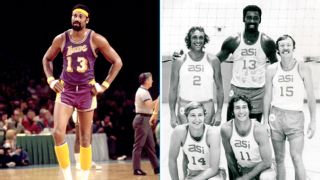 The Big Dipper wasn't just big, though at 7-foot-1, he was certainly that. He was a tremendous athlete who starred in both basketball and track in high school (Overbrook in Philadelphia) and college (Kansas). Heck, in his three Big Eight Conference track and field championships, he ran the 100-yard dash, threw the shot put and won the high jump each time. And then he became the most dominant center in NBA history, making 13 All-Star teams for the Warriors, 76ers and Lakers while winning four league MVPs. Once upon a time -- March 2, 1962, in Hershey, Pennsylvania -- he scored 100 points as his Philadelphia Warriors beat the New York Knicks 169-147. Sixteen years later, he was enshrined in the basketball Hall of Fame in Springfield, Massachusetts. Just 9 miles north, in Holyoke, Massachusetts, is the International Volleyball Hall of Fame. Wilt is in that one, too. Wilt got there by way of the SoCal beach scene, where he took up the sport at the end of his basketball career. He became so passionate about it that he helped to start an indoor co-ed league, the International Volleyball Association, in the late 1970s. And he was good enough to be named MVP of the league's 1978 all-star game, televised on NBC. He died in 1999 at the age of 63 of congestive heart failure, eight years after writing this about his love of volleyball in his autobiography, "A View From Above": "Being able to hold my own against the best in the world, on the beach or indoors, is something I am very proud of." Katie Taylor, Ireland Even before she became one of Ireland's most famous athletes, they were writing songs about her: "Katie Taylor, Ireland's Boxing Legend" was a big hit for Coddle in 2012. That was the year she was the flag-bearer for Ireland in the London Olympics, then won the gold medal in the lightweight division. Now 32, she is undefeated as a professional and is ranked the 11th best boxer in the world, pound for pound, man or woman. Not to be forgotten, though, was the future she once had as a midfielder and forward on the Republic of Ireland's football team. The teenage Taylor once scored four goals in a UEFA qualifier against Macedonia. Had boxing not gotten in the way, they might have been writing "Katie Taylor, Ireland's Football Legend." In a 20-year-old video, her past recently came back to haunt her -- and Kenny Hammond, now a plumber. Back then, he was a midfielder for a very good Cherry Orchard U-12 team that had to play the Newtown Juniors. As luck would have it, he drew the only girl on their team -- Katie Taylor. The video, which went viral last winter, shows him being taken down from behind by No. 7 in red. "She'd be pulling you, kicking you," Hammond told Irish newspaper The Daily Edge. "She was dirty." Then, with a laugh, he said, "At least she's allowed to use her fists now." Joel Embiid, Cameroon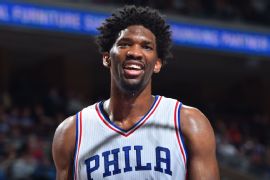 Some 40 years after a formerly dominant 76ers center took up volleyball, a volleyball player from Yaounde, Cameroon, took up basketball -- and became a dominant 76ers center. "My father didn't want me to play basketball," said the 7-foot Embiid, who last year became the first 76er to start an All-Star Game since Allen Iverson in 2009-10. "He thought it was too physical for me." His father, Thomas, was a military officer in Cameroon, so it was a little hard to disobey his orders. The original plan was for Joel to go to Europe to play pro volleyball. But then Luc Mbah a Moute, an NBA player from Yaounde, discovered him and convinced Thomas that basketball in the United States was the 15-year-old's destiny. The road was a little bumpy -- Embiid's first American high school coach didn't play him. But he became such a star at The Rock School in Gainesville, Florida, that Kansas recruited him, and after one year there, the 76ers made him the third overall pick in the 2014 draft. A foot injury kept him from playing his first two seasons but also inspired his nickname, "The Process" -- a reference to then-general manager Sam Hinkie's mantra, "Trust the process." What Mbah a Moute, the Jayhawks and the 76ers saw was Embiid's incredible athleticism and a skill set forged by soccer and volleyball. "They gave me the footwork," Embiid said, "the ability to move side to side, and the instincts on defense." In 63 games last season, Embiid averaged 11 rebounds and 22.9 points. More importantly, he impressed his most demanding critic. "He's still learning," said his father. "When he plays four or five years, he'll get better and better." Stephen Neal, United States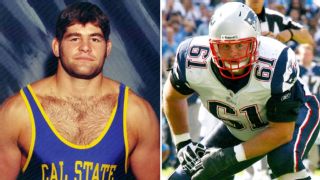 The fans at Penn State's Bryce Jordan Center for the 1999 NCAA Wrestling Championships thought the heavyweight final they were watching would determine whether Iowa or Minnesota would win the overall title. But what they were really seeing was a match between two competitors who would make names for themselves in very different arenas. It was, as the ESPN2 commentator said, "the power of newcomer Brock Lesnar versus the experience of a very talented athlete in Stephen Neal." In a very tight match, Cal State-Bakersfield's Neal won 3-2 to defend his title and deny the Gophers. Lesnar, of course, went on to fame as a WWE and UFC champion, with a side trip to Minnesota Vikings camp in 2004 to see if he could play defensive tackle. He couldn't, but had he succeeded, he might have had to face Neal once again. A four-time Academic All-American, Neal decided to give NFL football a try despite the fact that he hadn't played since high school. The New England Patriots and Philadelphia Eagles both tried him at offensive guard in 2001 only to cut him. But, Neal says, "I'm a very stubborn person." He won over Bill Belichick the second time around and eventually won the right guard job, starting 81 games for the Pats and getting three Super Bowl rings. When Neal retired because of a shoulder injury after the 2010 season, Belichick said, "Steve may have accomplished more than any player I have ever been around." Althea Gibson, United States There is no overstating the impact that this daughter of sharecroppers had on American society, much less the world of sports. Because of her courage and talents, she did for tennis what Jackie Robinson did for baseball: broke down the longstanding barriers of racism. Born in South Carolina in 1927, raised in Harlem, New York, and educated at Florida A&M, Gibson became the first person of color to win a Grand Slam title when she captured the French Open in 1956. The next year, after winning Wimbledon, she was given the Venus Rosewater Dish by Queen Elizabeth II. "Shaking hands with the Queen of England," she once said, "was a long way from being forced to sit in the colored section of the bus." At the height of her fame, after her second U.S. Open singles title in 1958, the press followed her into a sporting goods store, where she bought a new set of golf clubs. "Gentlemen," she boasted. "You now are looking at the next women's golf champ." They thought she was joking. But when the memories of the ticker-tape parade, the magazine covers and the record album had begun to fade away, when her pro tennis career was reduced to warming up before Harlem Globetrotters games, Gibson decided to return to the sport she learned to love at Florida A&M. In 1963, she applied for her LPGA card. To qualify to become the tour's first black player, she needed to finish in the top 80 percent in three out of four tournaments -- which she did at a golf club where she wasn't allowed to dress, shower or eat. On her first year on the tour, she made only $561.50, but she kept at it, usually driving from tournament to tournament, encountering resentful motel clerk after resentful motel clerk. In 1966, at the age of 39, she finished 27th on the tour, and in 1970, she nearly won the Buick Open. "Althea might have been a real player of consequence had she started when she was young," said her rival, Judy Rankin. She didn't call it quits until 1978, after 171 tournaments and a grand total of $19,250.25 in prize money. When she passed away in 2003 at the age of 76, she was remembered as a great tennis champion who paved the way for Arthur Ashe and the Williams sisters. Very little mention was made of her golfing career, but in a way, that defined her grace and resilience as much as tennis did. Jordan Mailata, Australia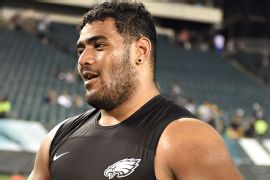 The skill set for American football matches up well with both rugby and Australian Rules Football, so over the years, there have been a number of Pacific Rim athletes who have tried to find a place in the NFL, such as Sav Rocca (punter, Eagles and Redskins); Hayden Smith (tight end, Jets) and Jarryd Hayne (running back, 49ers). The latest such crossover is Jordan Mailata, who's trying to make the Super Bowl champion Philadelphia Eagles as an offensive tackle after starring in rugby league for the South Sydney Rabbitohs. The Eagles drafted the 6-foot-8, 346-pound Mailata in the seventh round off his impressive pro day at the IMG Academy in Bradenton, Florida, and so far ... well, not so good. The other day he was pancaked in practice by DE Steven Means, and afterward, he said, "It was, 'Welcome to America. Welcome to the NFL. Welcome to Jumanji.'" But with his size and speed and an impressive body fat percentage -- below 10 percent -- he still remains an intriguing prospect. And he has won over his teammates with his positive attitude and his musical chops -- in the traditional rookie show at camp, he played the guitar and nailed "Hold" by Brisbane's own Mark Lowndes. There's a plaintive line in the song that might have hit home with the coaches: "I will wait." Herschel Walker, United States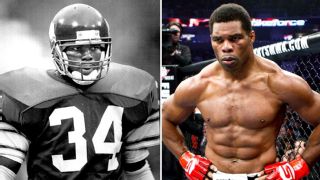 What possesses an athlete to attempt to excel in a sport beyond his or her destiny? The multitalented people profiled here have in common a hypercompetitive spirit and a refusal to say no to conventional wisdom. But with Herschel Walker, one of American football's greatest running backs, a collegiate track star, a member of the 1992 USA Olympic bobsled team and the winner of multiple MMA fights after he turned 50, the explanation is not quite so simple. As Walker once told soldiers of the Army's 10th Mountain Division at Fort Drum, New York, he suffered from dissociative identity disorder (DID), a condition once known as multiple personality disorder. After being bullied as a child because he stuttered and was overweight, he transformed himself. "I went from being the worst athlete in my school to being one of the fastest kids in the state of Georgia," he told the troops. He ended up winning the 1982 Heisman Trophy at the University of Georgia and rushing for 13,787 yards in his 15-year pro football (USFL and NFL) career. And he still managed to finish seventh as the brakeman for Brian Shimer at the Albertville Winter Games in 1992. "After football, I didn't have that coping mechanism anymore," he said, comparing their experience in combat to his own. "When you bring that 'zone' off that field of play into your home ... it scares people." Walker briefly toyed with the idea of returning to the MMA ring, but for now, he continues to serve as a spokesman for mental health issues and runs his thriving chicken-production business, Renaissance Man Foods. Manny Pacquiao, Philippines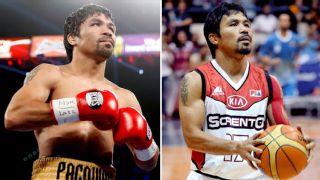 He is the first boxer in history to win major world titles in four of the original weight classes: flyweight, featherweight, lightweight and welterweight. On ESPN's list of top pound-for-pound boxers over the past 25 years, he is No. 2, behind Floyd Mayweather. Now 39 and a senator, Pacquiao hopes to go from the political ring back to the boxing ring this December to defend his WBA welterweight title. But before that, he has a little hoops to play. Pacquiao loves basketball, so much so that he was a player-coach for the Kia Carnival in the Philippine Basketball Association for several years. (For the record, he was drafted 11th overall at the inaugural draft in 2014.) He wasn't a prolific scorer -- his career high was four points -- but in various film clips, he displays a nice shooting touch with the pretzel-like PBA ball. He is also confident enough to have challenged Mayweather to a one-on-one match. Now he has his own league called, interestingly enough, the Manny Pacquiao Basketball League. There are 26 teams and one catch: No team can have more than one player taller than 6-foot-4. If anybody would like to argue, Manny will ask him to step outside. David Nalbandian, Argentina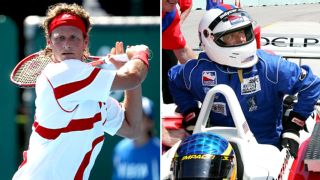 The only Argentinian to make the semifinals of all four Grand Slam tournaments, Nalbandian was always great on his returns. So, after his retirement from the ATP Tour in 2013, it didn't take him long to show up again on the sports wire. He arrived in a Chevrolet Agile. "It's different than tennis," he said of rally racing. "It's a novel kind of experience. ... Anything can happen. There are stones in the middle of a stage. Everything changes all the time." From the time he beat Roger Federer in the finals for boys' singles in the 1998 U.S. Open, Argentina hoped Nalbandian, born to a family of Armenian descent in Unquillo, might put the nation at center court of the tennis world, as Guillermo Vilas and Gabriela Sabatini had. And he was there for a while -- he lost in the finals of the 2002 Wimbledon to Lleyton Hewitt and nearly beat eventual champion Andy Roddick in the semifinals of the 2003 U.S. Open. But because of injuries and a mercurial temperament -- he was once disqualified from a tournament in England and charged with assault after a sign he kicked struck a line judge and opened a cut -- Nalbandian never truly excelled. Shoulder surgery in 2013 spelled the end of his tennis career and the beginning of his new adventure. Rally racing, which is also the post-career pursuit of former NHL great Teemu Selanne, is not without its risks. In November 2016, Nalbandian and his co-driver crashed their Agile during the Copa Maxi Rally in San Justo, Argentina. Unlike that line judge, neither driver was hurt. Simen Agdestein, Norway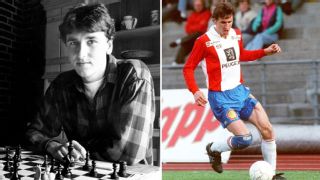 When playing with white pieces, the Norwegian grandmaster prefers to open with the King's Indian. With black, he favors the Dutch Defense. Nothing unusual there. What does distinguish Agdestein from his opponents, though, is the way he began his athletic career. He was a football player before he took up chess, and for years he played at the highest levels of both sports. "When I came home from school," he once said, "I slept a little, then it was out to football training, and when I got home, I sat up and read chess into the night." When he was 15, the Oslo native won the first of his seven national chess championships. When he was 17, he made his professional football debut with Lyn Oslo. By 21, he was a 6-foot-2 center forward on the national team who, befitting his chess background, liked to create chances. But four years later, he suffered an ACL injury that forced him to quit the game. He used the extra time to pass his knowledge of chess on to younger players, one of whom was a 9-year-old boy who would become one of the grandest of the grandmasters: Magnus Carlsen. At the age of 51, Agdestein is still one of the best chess players in Norway. But he looks back on his football career with a mixture of joy and regret. "Football was such fun," he once told an interviewer. "I still don't like to watch football very much -- the feeling that 'I could have been there' is still there." Lolo Jones, United States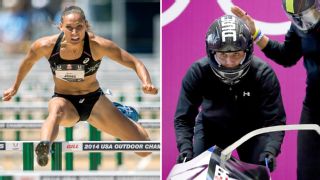 Give her a break. She overcame a peripatetic childhood to become a track star at LSU and a favorite to win the 100-meter hurdles at the 2008 Beijing Olympics only to clip the ninth of 10 hurdles while in the lead and stumble to seventh. In 2012, when she took a sabbatical from track to try out for the USA bobsled team, the New York Times wrote that the audition "was based not on achievement but on her exotic beauty and on a sad and cynical marketing campaign." And when she made the team for the 2014 Sochi Games, one of the women cut said, "I should have been working harder on gaining Twitter followers than gaining muscle mass." The fact that her sled finished 11th didn't help matters. But in a less demanding world, "I told you so" might have been "You go, girl." Only a handful of athletes have ever competed in both the Summer and Winter Olympics, and only one, Eddie Egan, has won gold in both: light heavyweight boxing in the 1920 Antwerp Games and four-man bobsleigh at Lake Placid in 1932. To Jones' everlasting credit, she has continued to train for both track and bobsled. She was a last-minute cut from the team that went to Pyeongchang and had to wonder what might have been when her driver, Elana Meyers Taylor, finished second to Canada's sled by seven-hundredths of a second. And after taking two years off from hurdling after hip surgery, she hasn't given up hope of making the Summer Olympics team for the 2020 Tokyo Games, when she will turn 38. "I still have a little bit left in these legs," she said. Not to mention heart.
|

